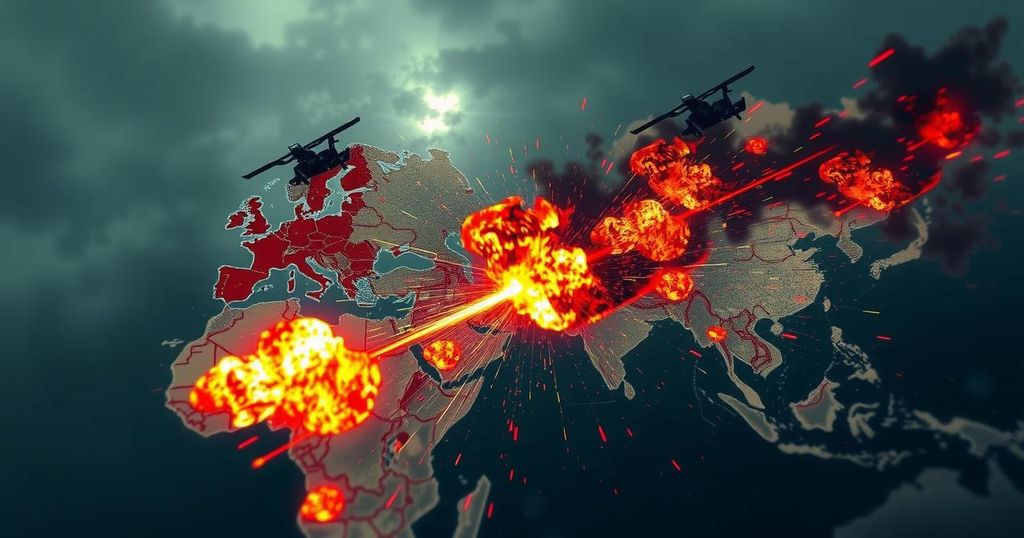Sudan’s Civil War: A Disturbing Reflection of Libya and Syria’s Conflicts
The civil war in Sudan, now progressing into its second year, has emerged as a distressing reflection of the tragic historical conflicts experienced in Libya and Syria. This humanitarian crisis has resulted in the loss of over 40,000 lives and has displaced more than 10 million individuals. As in the earlier Middle Eastern uprisings, Sudan’s conflict traces its origins to a public uprising that has escalated into a complex and bloody civil war, with implications that threaten to destabilize neighboring countries. The recent peace talks in Geneva, sponsored by the United States, have failed to engage key factions, thereby diminishing prospects for a rapid resolution. These developments suggest that Sudan may be on a protracted trajectory similar to that of Syria and Libya, where external interventions, regional tensions, and domestic rifts have exacerbated suffering and instability.
The antecedents of Sudan’s civil turmoil date back to 2019, following the successful ousting of long-standing President Omar al-Bashir by Sudanese protesters. This movement echoed the Arab Spring revolts of 2011, which led to the downfall of several autocrats in the region, including Muammar Qaddafi and Bashar al-Assad. Unfortunately, as observed in these prior conflicts, the initial aspirations for democratic reform quickly devolved into chaos and violent confrontations.
In Libya and Syria, the downfall of authoritarian regimes precipitated immediate disputes and violence. Libya faced rapid descent into civil war as factions supporting and opposing Qaddafi clashed. Similarly, Syria’s peaceful demonstrators were met with brutal government crackdowns, which catalyzed the armed opposition and commenced a relentless conflict. Conversely, Sudan initially witnessed a brief interlude of cooperation among the military, the Rapid Support Forces (RSF), and civilian leaders. However, this uneasy alignment disintegrated in 2023 as the RSF and the military turned against one another, effectively marginalizing the voices of civilian leaders and triggering full-scale warfare.
This evolution from peaceful protests to armed conflict, wherein original demonstrators become sidelined, is a common narrative shared by Syria, Libya, and now Sudan. In Syria, many protestors initially resisted armed insurgency but were ultimately overshadowed by factions promoting violent measures. The opposition transformed as extremist groups and militias gained the upper hand, obscuring the essence of the 2011 movement. Similarly, in Libya, the leadership of the second civil war, ignited three years post-Qaddafi’s ousting, diverged from the initial revolutionary coalition. The current Sudanese battleground prominently features RSF and military forces, relegating the civilian representatives of the protests to the periphery.
Moreover, the international community’s response to Sudan’s plight evokes comparisons to the global stance taken towards Libya and Syria. Notably, Western governments, particularly the United States, have adopted a largely non-intrusive position, promoting peace discussions without exerting tangible influence on the ground. This restraint has allowed non-Western powers, especially Middle Eastern nations, to assert their influence, complicating the resolution process.
Reflecting on prior conflicts, Libya witnessed NATO’s intervention in 2011 which, while intended to protect anti-Qaddafi elements, ultimately enabled civil strife to proliferate. In Syria, the United States restricted its involvement primarily to counterterrorism initiatives against ISIS, largely distancing itself from the broader civil war. Presently, in Sudan, American-backed peace negotiations have faltered, restrained by the limited influence attributed to western powers amidst intractable local factions.
The involvement of non-Western entities in Sudan’s conflict parallels the dynamics observed in Libya and Syria. Reports from Amnesty International indicate the influx of arms and military supplies from nations such as China, Russia, and Turkiye, further complicating the conflict. In Libya, regional supporters fragmented the already volatile situation, while in Syria, the intervention from various states has prolonged hostilities for over a decade. As Sudan witnesses similar foreign interventions, the prospects of achieving a peaceful resolution grow increasingly bleak.
An alarming consideration is the potential for Sudan’s turmoil to radiate outward into adjacent nations, a pattern reflective of the experiences witnessed in both Libya and Syria. The Syrian conflict has already destabilized Jordan and Lebanon, induced violence within Turkey, and fostered extremism within Iraq. Similarly, Libya’s turmoil has spread violent repercussions across the Sahel region and has contributed to the migrant crises experienced in Europe since 2015.
Sudan shares its borders with seven nations: Mali, South Sudan, the Central African Republic, Ethiopia, Eritrea, Libya, and Egypt, three of which grapple with ongoing violence. The humanitarian crisis has resulted in 2.3 million Sudanese seeking refuge in neighboring states, intensifying the risks of destabilization across an already fragile region.
The refugee influx strains the limited resources of neighboring countries, many of which struggle to accommodate this challenge. The potential for the conflict to extend into these countries raises serious concerns about regional stability. Just as with Libya and Syria, Sudan’s war may engender widespread destabilization with dire consequences for global security.
The international community has a critical opportunity to distill lessons from the lessons of Libya and Syria, thereby averting another spiraling conflict in Sudan. However, this requires a degree of commitment and engagement that has thus far been insufficient. The experiences of the past emphasize the perils associated with minimal Western involvement and the dominance of regional powers in conflict scenarios.
Should Sudan’s conflict persist unchecked, the repercussions will undoubtedly be catastrophic not only for Sudan’s populace but also across the broader region. It is essential for the international community to acknowledge these historical lessons and take meaningful actions to preempt another lengthy and destabilizing conflict. The urgency for intervention is pressing, as the window for effective engagement narrows. The welfare of the Sudanese people hangs in the balance, and there is an imminent risk that neighboring populations may soon suffer the same fate.
The resonances of Libya and Syria serve as a poignant reminder: while history may not exact an identical repetition, it certainly manifests in tragic patterns that warrant urgent attention.








Post Comment